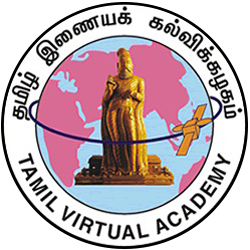Primary tabs
-
Lesson- 2
A02132 - இடைச்சொல் வகைகள் பகுதி-I
(Categories of இடைச்சொல் - Part I)
This lesson is concerned with the இடைச்சொற்கள் called வேற்றுமை உருபுகள் (case markers), வினை உருபுகள் (verbal endings), சாரியைகள் (aligned parts) and உவம உருபுகள் (comparative particles). You will also learn how these four types of
இடைச்சொற்கள் occur in poetic and speech traditions. You will be able to know how the nouns with
வேற்றுமை உருபுகள் (case markers) clarify the meaning. This lesson enables you to understand the references by the verbal endings and the middle parts indicating time (of occurrence), namely tense markers. Another part of a word called சாரியை depends on and coordinates with words you can use effectively in Tamil.வேற்றுமை உருபுகள், வினை உருபுகள், சாரியைகள் and உவம உருபுகள் are discussed in the first four units of this lesson. Of course the fifth unit summarises the lesson.
The functions of nouns change according to the வேற்றுமை உருபுகள் added to them. In Tamil there are eight (cases) வேற்றுமைகள். The first
வேற்றுமை (nominative case), is functioning as the subject of an expression, and the last and eighth வேற்றுமை (vocative case) do not take any வேற்றுமை உருபுகள். The second வேற்றுமை (accusative case) has ஐ as its marker, for the third வேற்றுமை (instrumental case) ஆல், ஆன், ஒடு, ஓடு and உடன் are the case markers. And so are the other வேற்றுமைகள் with their respective உருபுகள். Thus we come to know that பெயர்ச்சொல் undergoes a change in meaning, when it occurs with a case marker.Tamil verbs have six parts in general but may not always take all of them. But பகுதி, விகுதி and இடைநிலை are the three important parts. பகுதி indicates the action of the verb, இடைநிலை the tense and விகுதி the status, like gender, number and person. வினைவிகுதிகள் and காலம்காட்டும் இடைநிலைகள் are illustrated in the second unit.
சாரியைகள், another type of இடைச்சொல், form the subject of the third unit. சாரியை occurs before விகுதி and after இடைநிலை. This is a dependant ( சார்) and a co-occurring (இயை) part of a verb or a noun. சாரியைகள் can be of two types - பொதுச் சாரியை and எழுத்துச் சாரியை.
The fourth unit deals with உவமை as a comparison of one thing with another. Such comparison is expressed through parts called உவமஉருபுகள் (comparative particles) such as போல, ஒப்ப, இயைய and அன்ன. They are in fact like English words used in the use of similes.
In the summarizing unit of five you will study the importance of only four types of இடைநிலை. Other types will be taken up in subsequent lessons.


